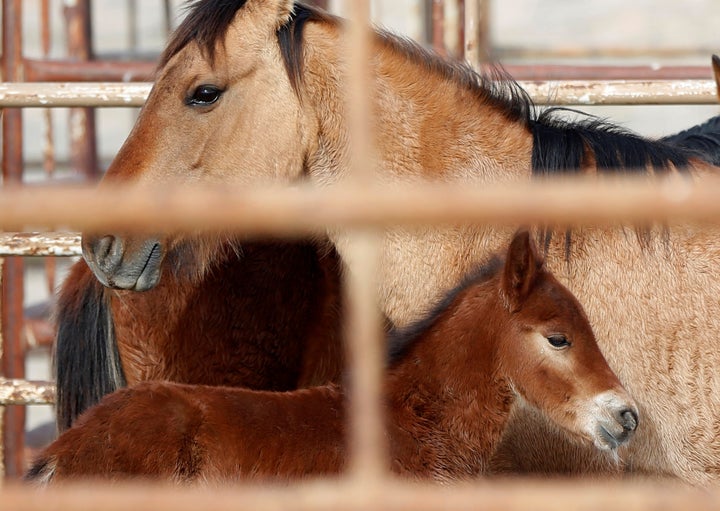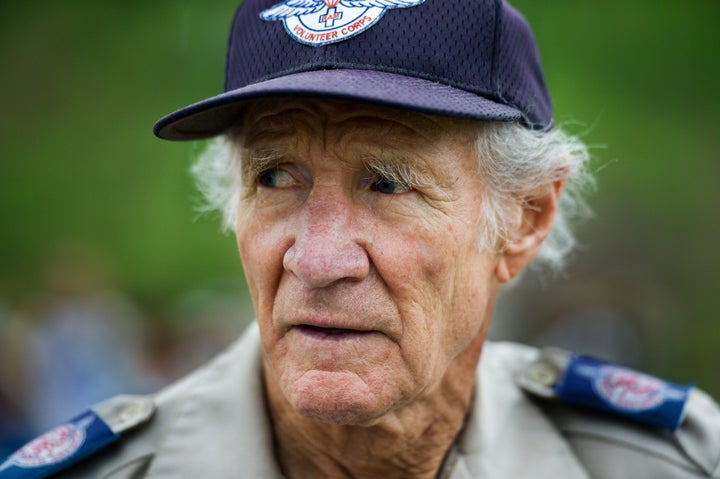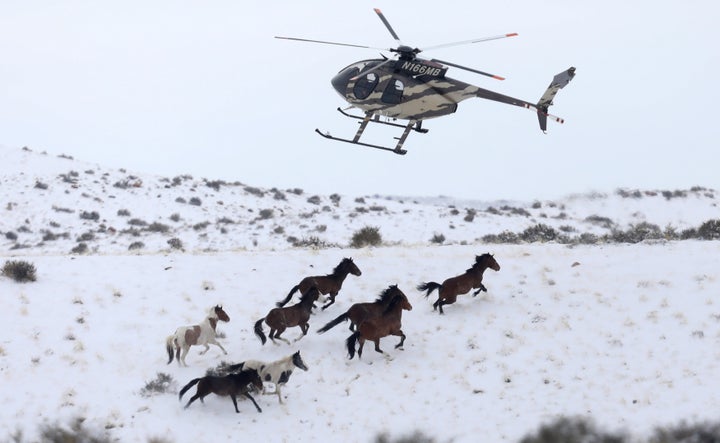
The Bureau of Land Management is reviewing a pair of proposals to relocate wild horses from the western United States to Guyana and Russia, part of an ongoing effort to manage the growing population.
British cowboy and philanthropist Stan Brock told HuffPost he has been working with the governments of the U.S. and Guyana for several years to develop a plan to transport mustangs to the South American country. Brock managed Guyana’s remote Dadanawa Ranch, one of the world’s largest cattle ranches, in the 1950s and ’60s. He later moved to the U.S. and in 1985 founded Remote Area Medical, a nonprofit that provides free medical and veterinary care.
He sees importing the horses to Guyana as a way to revive the country’s once-thriving livestock industry. Indigenous cowboys could use the horses to round up free-roaming cattle on thousands of acres of isolated savannah.
Managing the wild horse population in the U.S. is an expensive and contentious issue. In addition to the approximately 45,000 wild horses and burros currently in BLM holding facilities, there are an estimated 82,000 free-roaming animals across 10 western states, according to the agency’s figures. The BLM spends roughly $50 million annually on the confined herds and periodically rounds up free-roaming animals, a move it says is necessary to protect rangeland health. Critics, however, accuse the agency of kowtowing to cattle ranchers and overstating the impact horses have on the environment.
Moving horses to Guyana would not only relieve some pressure on the confined horse population but help “restore the livestock industry for the benefit of the Native American population,” Brock said. The proposal he submitted to BLM calls for an initial transport of 40 to 50 mustang mares, but Brock says he’s looking to relocate “a much larger number later on.” He is convinced the animals will adapt well in Guyana.
BLM spokeswoman Amber Cargile said the agency continues to explore options for managing wild horses and is “always interested when someone suggests a way to provide good, permanent homes for excess horses.” She confirmed BLM is “evaluating Mr. Brock’s proposal,” but that no final decision has been made.
Brock says he’s been in constant contact with the BLM and stressed that details are still being worked out.

Internal BLM emails from July 2017, which HuffPost obtained from Wild Horse Freedom Federation, a wild horse advocacy group, indicate federal officials are taking the proposal seriously. Staff met with Brock and his team on at least two occasions. In one email, Kristin Bail, BLM’s assistant director of resource and planning, wrote that the agency “continues to work with Dept. of State at options for shipment, perhaps developing an agreement with the proponent and others who want to help.”
Asked to comment, the State Department deferred to BLM.
Brock first approached BLM about purchasing mustangs more than eight years ago, but the plan fell through due to a lack of financial support for transporting the animals, according to documents the Wild Horse Freedom Federation obtained through a public records request and shared with HuffPost. The emails show Brock revived his proposal in June 2012 after an undisclosed financial group expressed interest in covering transportation costs.
Debbie Coffey, vice president of the Wild Horse Freedom Federation, said that while relocating the horses may seem like a reasonable proposal, “it opens the door for other circumstances in the future that may lead to our wild horses and burros entering a slaughter pipeline in other countries.”
Washington state resident Lon Ball, executive director of business development at Russian-American company OOO Rancho Khasan, has also offered a separate and far more sweeping proposal. Late last year, Ball approached BLM’s Wild Horse and Burro Program about adopting the entire population of confined mustangs ― upwards of 45,000 animals ― and shipping them to eastern Russia, to an area he’s dubbed “horse heaven.”
Ball said the plan was to use the horses to create a Western-themed resort that would primarily target Chinese eco-tourists.
The proposal, which Ball has since scaled back, expanded on one he submitted back in 2011 that angered horse advocates. Ball was looking to obtain 2,000 horses as part of a pilot project to relocate animals to eastern Russia, where he noted the animals would have plenty of room to graze and could serve as potential prey for imperiled predators.
“This is habitat for both the critically endangered Amur leopard and the endangered Siberian tiger,” Ball wrote in a 2011 email to BLM staffer Sally Spencer. “Poachers keep the ungulate numbers critically low and the habitat is nearly sterile for lack of prey.”
Although it was never part of Rancho Khasan’s proposals to BLM, internal emails obtained by HuffPost show that Ball and others at the company discussed the possibility of horses being slaughtered for human consumption. On Nov. 1, Anatoli Lebedev, the organization’s co-founder, wrote: “[F]or marketing we need a very clear picture ― how are we able to extract some horses for meat from the whole herd … without hurting hearts of animal rights activists, who trusted us?”
Ball told HuffPost the idea was simply floated internally as a possible national security argument that would ensure political and bureaucratic support in Russia. Ultimately, he said, the group decided not to go there.
Ball viewed his plan as a win-win for the horses and endangered big cats. Until recently he saw mass-export as the only logical solution for dealing with the confined horse population. But in a report to Congress in April, BLM proposed paying $1,000 to anyone who takes in a wild horse. Currently, BLM charges a $125 adoption fee.
BLM says it is looking at how it would implement such an incentive program and expects to release additional information later this year.

Ball described the $1,000 adoption incentive as “the only responsible way for BLM to exit their captive horse dilemma with grace.” In light of BLM’s proposal and the resistance Rancho Khasan has faced, Ball said his group has decided to limit the number of horses it would be willing to adopt to 2,000.
He added it is now up to horse advocates to embrace adoptions in order to save animals from being slaughtered and ensure they can remain in the U.S.
But horse advocates aren’t a fan of the adoption incentive plan, either. Susan Wagner, president and founder of Equine Advocates, argued that the plan could actually increase the chances of animals being slaughtered and abused. “
“All it would do is put money in the pockets of the very people who want to kill them, especially the ranchers who have the most land,” Wagner said via email. “Or they could be sold to people with no knowledge or expertise about handling and caring for wild equines, but who are only interested in taking the money.”
Ball said he has not communicated with BLM officials in months, and that the agency is likely unaware he is no longer interested in taking in the entire confined mustang population. BLM’s Cargile told HuffPost the agency is evaluating the viability of last year’s proposal but has not taken any action.
“For any proposal to sell or adopt wild horses abroad, there are numerous logistical challenges to consider,” she said in an email. “At the end of the day, any such action would have to ensure the humane placement of the animals above all else.”
Passed by Congress in 1971, the Wild Free-Roaming Horses and Burros Act declared wild horses and burros as “living symbols of the historic and pioneer spirit of the West” and required that the federal government manage and protect the herds.
Coffey finds it appalling that BLM is even considering proposals that could result in horses ending up as prey in some other country. She also fears animals could die during transportation or later be sent to slaughter.
“These are our treasures,” she said of America’s wild horses. “And this is what’s going to happen to them?”
It appears BLM previously had an informal policy against sending horses overseas. In 2011, in an email exchange responding to Ball’s initial proposal to transport 2,000 horses to Russia, Gregory Russell of the Interior Department wrote to several colleagues that the parent agency had “advised that the BLM would have limited ability to protect horses’ welfare once they’re out of the county.”
Over the years, the federal government and lawmakers have eyed numerous possible solutions for tackling the wild horse problem.
In 2016, BLM rejected the Wild Horse and Burro Advisory Board’s recommendation to euthanize all animals in government holding facilities. In its fiscal 2018 budget request, the Trump administration proposed allowing for “humane euthanasia and unrestricted sale of certain excess animals,” which would have opened the door for wild horses to be sold to slaughterhouses in Mexico or Canada. Congress ultimately spared wild horses by passing a spending bill in March that kept in place a ban on slaughtering the animals.
The Trump administration’s 2019 budget, now under review in Congress, also proposes allowing for the killing of horses.
